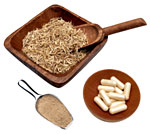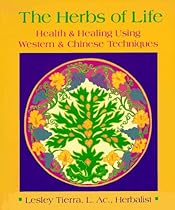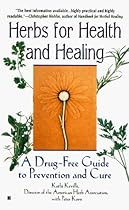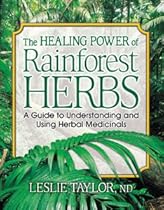David Hoffman, FNIMH, AHG
See book keywords and concepts |
 Too often, herbal products have been associated with adverse events because of mislabeling, which in turn results from either intentional or accidental substitution of botanical ingredients. The following quotation from DeSmet and D'Arcy may prove enlightening. Too often, herbal products have been associated with adverse events because of mislabeling, which in turn results from either intentional or accidental substitution of botanical ingredients. The following quotation from DeSmet and D'Arcy may prove enlightening. |
Heather Boon, BScPhm, PhD and Michael Smith, BPharm, MRPharmS, ND
See book keywords and concepts |
 Dennis Awang, a Canadian expert on herbal products, argues that the eleutherosides are in no way chemically similar to cardiac glycosides such as digoxin and have not been observed to have any cardiotonic effects. He argues that the case reported by McRae is most likely another case in which Periploca sepium is substituted for Eleutherococcus sentkosus because the former contains several cardiac glycosides which provide a more rational explanation for the rise in serum digoxin noted in the patient. Dennis Awang, a Canadian expert on herbal products, argues that the eleutherosides are in no way chemically similar to cardiac glycosides such as digoxin and have not been observed to have any cardiotonic effects. He argues that the case reported by McRae is most likely another case in which Periploca sepium is substituted for Eleutherococcus sentkosus because the former contains several cardiac glycosides which provide a more rational explanation for the rise in serum digoxin noted in the patient. |
David Hoffman, FNIMH, AHG
See book keywords and concepts |
 When such reports of reactions and interactions, as are available, are carefully analyzed, it becomes obvious that many of these cases where herbal products have been associated with actual human poisoning were not in fact caused by herbs alleged to be in the product, but resulted from substitution or contamination of the declared ingredients, intentionally or by accident, with a more toxic botanical, a poisonous metal, or a potent non-herbal drug substance.2
When evaluating causality of adverse events, a number of questions must be answered. When such reports of reactions and interactions, as are available, are carefully analyzed, it becomes obvious that many of these cases where herbal products have been associated with actual human poisoning were not in fact caused by herbs alleged to be in the product, but resulted from substitution or contamination of the declared ingredients, intentionally or by accident, with a more toxic botanical, a poisonous metal, or a potent non-herbal drug substance.2
When evaluating causality of adverse events, a number of questions must be answered. |
Mike Adams, the Health Ranger
See article keywords and concepts |
 And yet FDA regulations don't allow the manufacturers of these herbal products to tell you that they boost your defense against the flu and other infectious diseases. However, as an independent journalists and health commentator with absolutely no financial ties to these products or their manufacturers, I can give you an honest review of the products and tell you exactly what the research shows them to be good for. And yet FDA regulations don't allow the manufacturers of these herbal products to tell you that they boost your defense against the flu and other infectious diseases. However, as an independent journalists and health commentator with absolutely no financial ties to these products or their manufacturers, I can give you an honest review of the products and tell you exactly what the research shows them to be good for. |
David Hoffman, FNIMH, AHG
See book keywords and concepts |
 On the other hand, those working within the established scientific, medical, and legislative communities must acknowl-
Table 1.1. herbal products Being Evaluated Under an
IND Application [November 1998]
HERB INDICATIONS
Antineoplastons
Cancer
Arginine
Cancer
Chinese herbal
HIV-associated chronic synovitis
Plantar warts
Postmenopausal hot flashes
Ginkgo biloba
Cognitive impairment
Green tea extract
Cancer
Melatonin
Chronobiology, reproduction
Ozone therapy
Transfusion-related diseases
Saw palmetto
Benign prostatic hypertrophy
Shark cartilage
Cancer
St. On the other hand, those working within the established scientific, medical, and legislative communities must acknowl-
Table 1.1. herbal products Being Evaluated Under an
IND Application [November 1998]
HERB INDICATIONS
Antineoplastons
Cancer
Arginine
Cancer
Chinese herbal
HIV-associated chronic synovitis
Plantar warts
Postmenopausal hot flashes
Ginkgo biloba
Cognitive impairment
Green tea extract
Cancer
Melatonin
Chronobiology, reproduction
Ozone therapy
Transfusion-related diseases
Saw palmetto
Benign prostatic hypertrophy
Shark cartilage
Cancer
St. |
Lesley Tierra
See book keywords and concepts |
 American herbal products Association
P.O. Box 2410, Austin, TX, 512-320-8555 Devoted to herbal products, their manufacturing and quality.
Herb Research Foundation, 1007 Pearl St., Suite 200F, Boulder, CO 80302
American Herbalists Association
P.O. Box 1673, Nevada City, CA 95959
Rocky Mountain Herbalists Coalition
412 Boulder St., Boulder, CO 80302
Santa Cruz Herbalists Coalition
P.O. American herbal products Association
P.O. Box 2410, Austin, TX, 512-320-8555 Devoted to herbal products, their manufacturing and quality.
Herb Research Foundation, 1007 Pearl St., Suite 200F, Boulder, CO 80302
American Herbalists Association
P.O. Box 1673, Nevada City, CA 95959
Rocky Mountain Herbalists Coalition
412 Boulder St., Boulder, CO 80302
Santa Cruz Herbalists Coalition
P.O. |
Andrew Pengelly
See book keywords and concepts |
 And not without good reason: our recent understanding of the therapeutic uses of plants has revealed a number of significant issues which have the potential to impact on the quality, safety and efficacy of herbal products. It is therefore essential that all practitioners and students of herbal medicine, whatever their philosophical leanings, have the tools to understand and effectively manage these issues as they pertain to the wellbeing of their current or future patients. And not without good reason: our recent understanding of the therapeutic uses of plants has revealed a number of significant issues which have the potential to impact on the quality, safety and efficacy of herbal products. It is therefore essential that all practitioners and students of herbal medicine, whatever their philosophical leanings, have the tools to understand and effectively manage these issues as they pertain to the wellbeing of their current or future patients. |
Kathi Keville
See book keywords and concepts |
 Stocking
Your Herbal ^ i|l First-Aid Kit
If you are intrigued by herbal first-aid but simply don't know where to begin, start slowly by stocking your medicine chest with a dozen or so basic, versatile herbs and herbal products that can be used to treat minor injuries. As you begin to feel more comfortable with treatments of this kind, and as your knowledge of herbs grows, you will find yourself turning to herbs first in most first-aid situations. Eventually, you may find yourself preparing your own herbal products and maybe even growing or collecting your own medicinals. Stocking
Your Herbal ^ i|l First-Aid Kit
If you are intrigued by herbal first-aid but simply don't know where to begin, start slowly by stocking your medicine chest with a dozen or so basic, versatile herbs and herbal products that can be used to treat minor injuries. As you begin to feel more comfortable with treatments of this kind, and as your knowledge of herbs grows, you will find yourself turning to herbs first in most first-aid situations. Eventually, you may find yourself preparing your own herbal products and maybe even growing or collecting your own medicinals. |
Dr. Michael Heinrich, Joanne Barnes, Simon Gibbons and Elizabeth M. Williamson
See book keywords and concepts |
 The use of drug combinations is also not confined to herbal products; for example, cancer chemotherapy and the treatment of HIV and hypertension routinely use drug combinations. In addition, although many phytomedicines may have been characterized phytochemically, their mechanism of action is still unknown, which makes isolation of one constituent impossible.
ADVANTAGES AND DISADVANTAGES OF MIXTURES/COMBINATIONS
In general, synergistic and other interactive effects of mixtures are considered to be positive, with the low doses used perceived as a benefit. The use of drug combinations is also not confined to herbal products; for example, cancer chemotherapy and the treatment of HIV and hypertension routinely use drug combinations. In addition, although many phytomedicines may have been characterized phytochemically, their mechanism of action is still unknown, which makes isolation of one constituent impossible.
ADVANTAGES AND DISADVANTAGES OF MIXTURES/COMBINATIONS
In general, synergistic and other interactive effects of mixtures are considered to be positive, with the low doses used perceived as a benefit. |
Heather Boon, BScPhm, PhD and Michael Smith, BPharm, MRPharmS, ND
See book keywords and concepts |
 The United States of America herbal products in the United States are regulated as "dietary supplements" as defined by The Dietary Supplement Health and Education Act of 1994 (DSHEA). This definition also encompasses nutritional supplements such as vitamins, minerals, amino acids and botanical medicines. Companies marketing "dietary supplements" cannot make specific therapeutic claims regarding their products (i.e., about using them to diagnose, prevent, mitigate, treat or cure a specific disease. The United States of America herbal products in the United States are regulated as "dietary supplements" as defined by The Dietary Supplement Health and Education Act of 1994 (DSHEA). This definition also encompasses nutritional supplements such as vitamins, minerals, amino acids and botanical medicines. Companies marketing "dietary supplements" cannot make specific therapeutic claims regarding their products (i.e., about using them to diagnose, prevent, mitigate, treat or cure a specific disease. |
Dr. Michael Heinrich, Joanne Barnes, Simon Gibbons and Elizabeth M. Williamson
See book keywords and concepts |
 Although papaverine is of natural origin, it is only suitable for self-medication after medical diagnosis, but there are several herbal products available, which claim to treat this distressing disorder. The most common is yohimbe, a traditional aphrodisiac, and there are others, which are often strange botanical mixtures and usually sold under the description 'Herbal Viagra'. There is no real evidence of efficacy for any of these, although they may have a placebo effect.
Yohimbe, Pausinystalia yohimbe (K. Schum. Although papaverine is of natural origin, it is only suitable for self-medication after medical diagnosis, but there are several herbal products available, which claim to treat this distressing disorder. The most common is yohimbe, a traditional aphrodisiac, and there are others, which are often strange botanical mixtures and usually sold under the description 'Herbal Viagra'. There is no real evidence of efficacy for any of these, although they may have a placebo effect.
Yohimbe, Pausinystalia yohimbe (K. Schum. |
| The total recommended maximum dose of these alkaloids is less than 1 tig daily for less than six weeks per year. If herbal products, which may contain these, are to be employed (and some are very useful, e.g. butterbur and coltsfoot; see Chapter 15), the content must be estimated and if necessary the alkaloids should be removed before use.
H CH3
OH f."CH3
yo
\ f
-0
V-N^y
Senecionine
Aristolochic acid
Most species of birthwort {Aristolochia, known as snake-root) contain aristolochic acid and aristolactams. |
| In summary, the use of herbal products continues to be a popular healthcare choice among patients and the general public. Most pharmacies sell herbal medicines and it is likely that pharmacists will be asked for advice on such products or that they will have to consider other implications of herbal product use, such as interactions with conventional medicines. It is intended that this book will provide the scientific background to the use of plants as medicines.
REFERENCES AND FURTHER READING
Barnes J. Mills SY. |
| Herbal medicines that are 'industrially produced' are required to hold a marketing authorization, but, as this term is not defined in law, small-scale manufacturers have been permitted legally to sell products under the exemption. Many herbal products are marketed as food supplements, without making medical claims, and are regulated under food, not medicines, legislation.
Traditional medicines used by ethnic groups include traditional Chinese herbal medicines (TCHM) and Ayurvedic medicines. These products are subject to the same legislation as are 'Western' herbal medicines. |
Josef A. Brinckmann and Michael P. Lindenmaier
See book keywords and concepts |
 According to the American herbal products Associations' Herbs of Commerce, psyllium is the Standard Common Name for the seeds of Plantago arenaria (syn. P. psyllium), P. asiatka, and P. ovata (syn. P. ispaghula).
Wording of the package insert German Standard License (St. Zul. 11th Suppl, Published February 1996)
Excerpt from the German Commission E monograph
(BAn% no. 223, Published November 30, 1985;'
Revised BAn% no. 50, Published March 13, 1990)
Uses
Chronic constipation, irritable bowel. Contraindications
Stenosis of the esophagus or the gastrointestinal tract. According to the American herbal products Associations' Herbs of Commerce, psyllium is the Standard Common Name for the seeds of Plantago arenaria (syn. P. psyllium), P. asiatka, and P. ovata (syn. P. ispaghula).
Wording of the package insert German Standard License (St. Zul. 11th Suppl, Published February 1996)
Excerpt from the German Commission E monograph
(BAn% no. 223, Published November 30, 1985;'
Revised BAn% no. 50, Published March 13, 1990)
Uses
Chronic constipation, irritable bowel. Contraindications
Stenosis of the esophagus or the gastrointestinal tract. |
| Data on the type of extraction solvent is not required for calculating the contents of active constituents; however, such data is relevant for herbal products with different types of constituents since it reveals information about the extraction of specific constituent groups. For example, in the category of urological remedies, netde root preparations produced with ethanol 20% or 90% are available. |
| Contamination with aflatoxins
Limits for aflatoxins in food products (such as walnuts and peanuts) have also been issued for herbal products. The German aflatoxin regulations of July 19, 2000 indicate the following upper limits:
Aflatoxin Bl maximum 2 ug/kg
Sum of the aflatoxins
Bl, B2, Gl, G2 maximum 4 ug/kg
Contamination with heavy metals
The increased health consciousness of the consumer during the last 10—15 years has resulted in an acute awareness of heavy metal contamination in nutri-
Recommended upper limits for heavy metals
Lead
5 mg/kg
Cadmium
0.2 mg/kg
Mercury
0. |
Richard P. Brown, M.D., and Patricia L. Gerbarg, M.D.
See book keywords and concepts |
 Rhodiola rosea has not shown any adverse interactions with prescription medications or with other herbal products. Be aware, though, that if you are taking a stimulating medication, Rhodiola rosea may increase the stimulant action.
To date, no controlled scientific studies have examined the effects of Rhodiola rosea in women who are pregnant or breastfeeding. There is no reason to think that the herb would be harmful, but until we have more information, we do not feel comfortable recommending it for moms-to-be or new moms. Rhodiola rosea has not shown any adverse interactions with prescription medications or with other herbal products. Be aware, though, that if you are taking a stimulating medication, Rhodiola rosea may increase the stimulant action.
To date, no controlled scientific studies have examined the effects of Rhodiola rosea in women who are pregnant or breastfeeding. There is no reason to think that the herb would be harmful, but until we have more information, we do not feel comfortable recommending it for moms-to-be or new moms. |
Leslie Taylor, ND
See book keywords and concepts |
 European Union has disappeared.
Other countries have already adopted either full or partial CODEX regulations concerning nutritional supplements. The results? In Germany, until 1996, one could freely purchase 500 mg vitamin-C tablets, the way you can here. Now the highest dosage available to Germans is 200 mg; anything higher is sold through pharmacists at extremely high prices and only with a prescription. All herbs are regulated as drugs and manufactured only by German pharmaceutical companies, available to consumers only by prescription. European Union has disappeared.
Other countries have already adopted either full or partial CODEX regulations concerning nutritional supplements. The results? In Germany, until 1996, one could freely purchase 500 mg vitamin-C tablets, the way you can here. Now the highest dosage available to Germans is 200 mg; anything higher is sold through pharmacists at extremely high prices and only with a prescription. All herbs are regulated as drugs and manufactured only by German pharmaceutical companies, available to consumers only by prescription. |
Dr. Michael Heinrich, Joanne Barnes, Simon Gibbons and Elizabeth M. Williamson
See book keywords and concepts |
 When PLRs were reviewed, manufacturers of herbal products intended for use in minor self-limiting conditions were permitted to rely on bibliographic evidence to support efficacy and safety, rather than being required to carry out new controlled clinical trials. So, many licensed herbal medicinal products have not necessarily undergone stringent testing. When PLRs were reviewed, manufacturers of herbal products intended for use in minor self-limiting conditions were permitted to rely on bibliographic evidence to support efficacy and safety, rather than being required to carry out new controlled clinical trials. So, many licensed herbal medicinal products have not necessarily undergone stringent testing. |
H. Winter Griffith, M.D.
See book keywords and concepts |
 Don't take with:
Any other prescription or nonprescription drug, vitamins, minerals or herbal products without consulting your doctor or pharmacist.
OVERDOSE
SYMPTOMS: Unknown effects. WHAT TO DO:
If an overdose is suspected, call the doctor or call poison center 1-800-222-1222.
0
SYMPTOMS
WHAT TO DO
Life-threatening:
None expected.
Common:
None expected.
Infrequent:
Dizziness, headache, constipation, confusion.
Continue. Call doctor when convenient.
Rare:
Fatigue, back pain, vomiting, sleepiness, high blood pressure. Other symptoms that occur. Don't take with:
Any other prescription or nonprescription drug, vitamins, minerals or herbal products without consulting your doctor or pharmacist.
OVERDOSE
SYMPTOMS: Unknown effects. WHAT TO DO:
If an overdose is suspected, call the doctor or call poison center 1-800-222-1222.
0
SYMPTOMS
WHAT TO DO
Life-threatening:
None expected.
Common:
None expected.
Infrequent:
Dizziness, headache, constipation, confusion.
Continue. Call doctor when convenient.
Rare:
Fatigue, back pain, vomiting, sleepiness, high blood pressure. Other symptoms that occur. |
C. P. Khare
See book keywords and concepts |
 Triphalaa Churna (Shaarangadhdara Samhitaa) is one of the largest-selling herbal products over-the-counter; used as a household remedy for regulating digestion.
Triphalaa is an important ingredient in Avipat-tikar Churna (Bhaishajya Ratnaavali), Sanjivani Vati (Shaarangadhara Samhitaa), Triphalaadi Taila (Sahasrayoga), Chinchaadikaa Leha (ibid).
Triphalaa Ghrita (Shaarangadhara Samhitaa) and Mahaa-Triphallaadya Ghrita (Bhaishajya Ratnaavali) are prescribed internally in diseases of the eye, and for promoting eyesight. Triphalaa Churna (Shaarangadhdara Samhitaa) is one of the largest-selling herbal products over-the-counter; used as a household remedy for regulating digestion.
Triphalaa is an important ingredient in Avipat-tikar Churna (Bhaishajya Ratnaavali), Sanjivani Vati (Shaarangadhara Samhitaa), Triphalaadi Taila (Sahasrayoga), Chinchaadikaa Leha (ibid).
Triphalaa Ghrita (Shaarangadhara Samhitaa) and Mahaa-Triphallaadya Ghrita (Bhaishajya Ratnaavali) are prescribed internally in diseases of the eye, and for promoting eyesight. |
Leslie Taylor, ND
See book keywords and concepts |
 Capsules and tablets are certainly more convenient and easier to take, and they don't taste bad, but sometimes they just won't be as effective as a foul-tasting herbal decoction or tincture. There can be some adaptations, however. As a general rule of thumb, many plants that are traditionally prepared as infusions and cold macerations have active chemicals that are soluble in water. This means that the plant can probably be taken in a tablet or capsule form since the chemicals will be broken down and dissolved in the digestive tract. Capsules and tablets are certainly more convenient and easier to take, and they don't taste bad, but sometimes they just won't be as effective as a foul-tasting herbal decoction or tincture. There can be some adaptations, however. As a general rule of thumb, many plants that are traditionally prepared as infusions and cold macerations have active chemicals that are soluble in water. This means that the plant can probably be taken in a tablet or capsule form since the chemicals will be broken down and dissolved in the digestive tract. |
Larry Trivieri, Jr.
See book keywords and concepts |
 Mark Blumenthal, Executive Director, American Botanical Council
"The use of herbal products requires that people learn about their benefits and their potential risks," says Mark Blumenthal. "People must realize that herbs can have some risks if they are not used properly and responsibly. But one of the major problems in the U.S. is the lack of an effective, rational regulatory system that allows the therapeutic benefits to be put onto the label of herbal products. Mark Blumenthal, Executive Director, American Botanical Council
"The use of herbal products requires that people learn about their benefits and their potential risks," says Mark Blumenthal. "People must realize that herbs can have some risks if they are not used properly and responsibly. But one of the major problems in the U.S. is the lack of an effective, rational regulatory system that allows the therapeutic benefits to be put onto the label of herbal products. |
H. Winter Griffith, M.D.
See book keywords and concepts |
 Don't use with:
Other drugs, herbal products or supplements without consulting your doctor or pharmacist.
0
POSSIBLE
ADVERSE REACTIONS OR SIDE EFFECTS
SYMPTOMS
WHAT TO DO
Life-threatening:
None expected.
Common:
Diarrhea, headache, nausea, mild stomach pain.
Continue. Call doctor when convenient. Don't use with:
Other drugs, herbal products or supplements without consulting your doctor or pharmacist.
0
POSSIBLE
ADVERSE REACTIONS OR SIDE EFFECTS
SYMPTOMS
WHAT TO DO
Life-threatening:
None expected.
Common:
Diarrhea, headache, nausea, mild stomach pain.
Continue. Call doctor when convenient. |
| Don't take with:
Other drugs, herbal products or supplements without consulting your doctor or pharmacist.
0
POSSIBLE
ADVERSE REACTIONS OR SIDE EFFECTS
SYMPTOMS
WHAT TO DO
Life-threatening:
In case of overdose, see previous column.
Common:
Drowsiness.
Continue. Tell doctor at next visit.
Infrequent:
• Headache, diarrhea or constipation, upset stomach.
• Dry mouth, nose, throat.
Continue. Call doctor when convenient.
Continue. Tell doctor at next visit. |
| Don't use with:
Other drugs, herbal products or supplements without consulting your doctor or pharmacist.
0
POSSIBLE
ADVERSE REACTIONS OR SIDE EFFECTS
SYMPTOMS
WHAT TO DO
Life-threatening:
None expected.
Common:
Chills, fever, chest pain or tightness, hives or itching, flushed face, breathing difficulty, stuffy or runny nose, headache, sneezing, wheezing, sore throat, unusual tiredness or weakness, vomiting, rash (on face, scalp or stomach), reaction at injection site.
Call doctor right away. |
| Don't take with:
Other drugs, herbal products or supplements without consulting your doctor or pharmacist.
0 possible adverse reactions or side effects
SYMPTOMS
WHAT TO DO
Life-threatening:
Allergic reaction (hives, facial swelling, sweating, wheezing, loss of blood pressure, and consciousness).
Seek emergency treatment immediately.
Common:
Constipation, nausea, headache, appetite loss, drowsiness, pain, insomnia, mood swings, cold or flu symptoms, sweating.
Continue. Call doctor when convenient. |
| Don't take with:
Any other prescription or nonprescription drug, vitamins, minerals or herbal products without consulting your doctor or pharmacist.
0 possible adverse reactions or side effects
SYMPTOMS
WHAT TO DO
Life-threatening:
Rare allergic reaction— Breathing difficulty; swelling of hands, feet, face, mouth, neck; skin rash.
Discontinue. Seek emergency treatment.
Common:
• Chills, fever, muscle aches, headache, nausea.
• Injection site problems (pain, redness, swelling).
Discontinue Call doctor right away.
Continue. Call doctor when convenient. |
Larry Trivieri, Jr.
See book keywords and concepts |
 Herbs in Many Forms
Herbs and herbal products come in many forms and are now available not only in natural and gourmet food stores, but also grocery stores, drugstores, and mass market retail stores. Also, a number of mail-order purveyors sell herbal products, as do alternative and conventional health practitioners.
THE POLITICS OF HERBAL MEDICINE
The World Health Organization (WHO) recognizes that nearly 80% of the world population in developing countries is dependent on traditional medicine for primary health care. Herbs in Many Forms
Herbs and herbal products come in many forms and are now available not only in natural and gourmet food stores, but also grocery stores, drugstores, and mass market retail stores. Also, a number of mail-order purveyors sell herbal products, as do alternative and conventional health practitioners.
THE POLITICS OF HERBAL MEDICINE
The World Health Organization (WHO) recognizes that nearly 80% of the world population in developing countries is dependent on traditional medicine for primary health care. |












